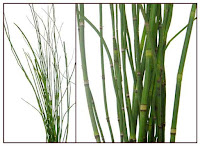When I chose herbs to talk or write about, I try to choose
ones that I’ve grown at one time or another.
That way I can speak with some experience on how well they do here.
Common Wormwood, Sailor's Tobacco, Felon Herb, Chrysanthemum
Weed, Wild Wormwood, Old Uncle Henry, Naughty Man, Old Man, White Sagebrush, Louisiana
Sagewort, Silver Wormwood, Cronewort are all common names for Mugwort. It is a self-seeding perennial with a long
history of culinary and medicinal uses though, it’s not used so much
today. Leaves were used as a bitter flavoring
for oils, meats and fish. And prior to
using hops, brewers used mugwort in making beer. This plant is attractive to bees, butterflies
and birds. Flowers are fragrant. It
should be planted in a sunny location and once established, it needs little water.
When carrying Mugwort you cannot be harmed by poison, wild
beasts or sunstroke. Always good to
know. And, taken as an infusion, it was
thought to cure madness.
The plant contains high levels of antioxidants, which help digestive
and intestinal problems. It works as an antiseptic, has skin-cell regenerative
properties and is good for healing wounds.
Components of mugwort are also being tested and studied as a possible
alternative treatment for some cancers.
It's a yellow dye, an insect repellant, an ingredient in
food dishes, and a possible treatment for conditions ranging from flatulence to
cancers. Not bad for something many consider a noxious weed.
This is a very unusual plant and I have to say, I was
totally surprised when I discovered that it is considered an herb. Horsetail
is native to both North America and Europe. It is one of only a few Equisetum
survivors from the dinosaur era.
Horsetail is fond of wet or boggy areas and thrives in poor
soil, making it a perfect choice for areas where other plants do poorly. Be
careful planting it because it is very invasive and once in the ground,
it is really hard to get it all out (voice of experience here). I first used horsetail in my ponds because (1)
it did very well and (2) The fish and turtles would not eat it to the
dirt. Nowadays, I keep it in a pot and
have the pot sitting in a large container of water. Horsetail prefers bright light or morning sun
only, high heat and humidity.
Horsetail contains silicic acid, saponins, flavonoids,
sterols, tannins, potassium, aluminum salts, manganese, magnesium, sulfur and
calcium. Historically, it has been used
to stop bleeding, repair broken bones and as a treatment for arthritis and osteoporosis. Also, it has fungicidal properties and
infusions can be used to treat powdery mildew and blackspot on roses. The dried stems have a high content of
crystalline silicon and have been used to scrub and polish tin and wood. And
last but not least, it can be used to summon snakes by making a whistle from
the stem.
So, did you know??? there are more than 30 varieties of Parley, but the most common are
curly-leaf and Italian or flat-leaf parsley. The flat-leaf has more flavor and
is more often used for cooking. Curly
tends to be used more often as a garnish. And, make sure you eat that piece of garnish
because chewing parsley will help with bad breath. While the leaves are most commonly used, you
can also put the stalks into soups or stews for flavoring. Parsley goes well with chicken, eggplant,
eggs, fish, lentils, mushrooms, seafood, pasta, peas, potatoes, rice, tomatoes
squash, and lemon. Add it at the
beginning of the cooking process – it will keep its flavor but lose its color.
Parsley is a biennial (which means year 1 it will grow like
mad and year 2 it will bloom, make seeds, and die). It belongs to the same family as dill. It’s rich in iron and vitamins A and C. Plant it in a well-drained sunny place. It lends itself fairly well as a potted
plant. It attracts butterflies and is
the
larval food for the Black Swallowtail Butterfly.
It has been used in the treatment of prostate, liver and
spleen diseases, as well as anemia, arthritis, and microbial infections. It has
also been found useful as a diuretic and laxative.
Parsley is a great companion plant. Grow it with asparagus, chives, carrots,
corn, chilies and sweet peppers, onions, peas, roses and tomatoes. Planting parsley at the base of your roses
will increase their fragrance. However,
you don’t want to plant it with mints or lettuce.
Homer tells of chariot horses being fed parsley by warriors
prior to battle in hopes of making the animals more fleet of foot. And in
ancient times, parsley wreaths were used to ward off drunkenness. So, next time you head for the local pub …..
Parsley seeds tend to be very small and very slow to
germinate. It was said that the reason
for the slow and unreliable germination is that the seed goes nine times to the
Devil and back before coming up. The ungerminated seeds are the ones that the
Devil keeps for himself. Additionally, it was thought that parsley would only
grow when the woman was master of the household.
Take care








No comments:
Post a Comment